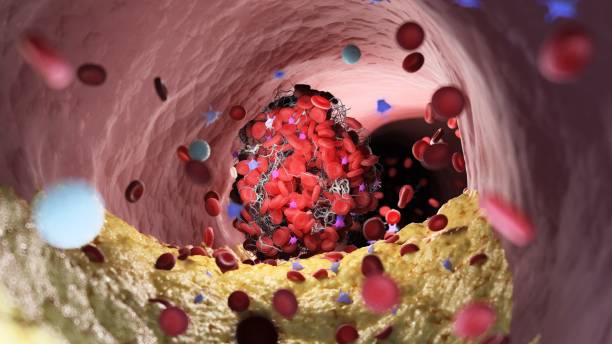
A blood clot in a vessel might have varying sensations depending on its location in the body. Clotting is essential to stem blood loss from a broken blood vessel but may also block veins and arteries.
Pain, numbness/tingling, edema, and cutaneous warmth may arise from blocked blood flow. Lung, heart, and brain blood clots may kill.
When Can You Feel A Blood Clot?
A blood clot won't be felt until it inhibits blood flow. When the clot becomes large enough, it will plug the blood vessel, blocking blood flow.
Tissues and organs get less oxygen from reduced blood flow. This creates blood clot symptoms. Depending on kind and location, blood clots may form in days, hours, or minutes.
You may experience these two symptoms caused by blood vessel clots:
- Thrombosis: An immovable blood clot hasn't migrated throughout the body. Thrombus in a blood vessel is thrombosis. It usually begins in the legs or, less frequently, the arms. It takes days to weeks to feel this blood clot.
- Embolus: A clot or portion of a clot that moves through the circulatory system to another region of the body. Emboli may swiftly lodge in the lungs, heart, or brain, causing an embolism. Within hours, this might induce acute symptoms. Embolisms may kill if not recognized and treated immediately.
Causes Of Blood Clots
Common blood clot causes or risk factors include:
- Inactivity
- Smoking
- Atherosclerosis (buildup of plaques on the walls of arteries)
- COVID-19
- Having obesity
- Surgery
- Having cancer
Describing How Blood Clots Feel
Blood clots may cause minor inflammation and discomfort or serious symptoms, including chest pain, trouble breathing, and mental confusion.
You may be able to palpate a superficial blood clot with your fingertips, but you'll usually only experience its symptoms.
RELATED: Reduce Your Risk Of Blood Clots With These 5 Stretches
Arms And Legs
Blood clots may be superficial or deep in arteries or veins. Blood clots vary based on origin and depth. Here are several frequent extremity blood clots:
- Superficial vein thrombosis (SVT): SVT, also known as superficial thrombophlebitis, may cause discomfort and redness in the afflicted vein. A cord-like vein might also feel hard. The symptoms normally go away after two weeks.
- Deep vein thrombosis (DVT): DVTs are deep vein thrombosis in the lower leg, thigh, hip, pelvis, and arm. DVTs may cause extremities edema or tightness. Numbness, tingling, heaviness, redness, and warmth are some symptoms. The smaller, superficial veins surrounding the DVT might also swell.
- Arterial thrombosis: Venous clots impede blood from returning to the lungs and heart, but arterial clots prevent oxygenated blood from reaching tissues and organs. The extreme might seem pale, bluish, and chilly. This may cause amputation.
Lung
Pulmonary embolism is the most frequent form of a blood clot in the lungs (PE). Leg DVTs mainly cause PEs. An embolus moves to the right cardiac blood channels.
The clot subsequently blocks blood flow to the lungs in the pulmonary artery. Some persons have numerous lung emboli. PE symptoms originate from this sequence:
- Chest pain
- Shortness of breath
- Difficulty breathing
- Decreased oxygen level
- Hemoptysis (coughing up blood)
- Decreased blood pressure
- Increased heart rate
- Syncope (fainting)
- Unconsciousness
- Death
A PE is a medical emergency. Call 911 if you have DVT symptoms such as chest discomfort, shortness of breath, or hemoptysis.
DVT vs. Pulmonary Embolism
A nonmobile blood clot in the extremities is deep vein thrombosis. Pulmonary embolism occurs when a DVT fragment enters the lungs (PE). PEs are medical emergencies that need rapid treatment.
Heart
Heart attacks may result from coronary artery thrombosis, a blood clot in the arteries that feeds blood to the heart muscle. Usually caused by atherosclerosis. Clots may occur in heart chambers, often from atrial fibrillation or cardiomyopathy (severe heart muscle weakness).
The following symptoms may indicate a cardiac blood clot:
- Chest pain
- Shortness of breath
- Jaw pain
- Left arm pain
- Nausea
- Sweating
- Dizziness
- Unconsciousness
- Death
Brain
A brain blood clot may grow inside or embolize brain blood vessels owing to head trauma. A brain clot may cause stroke and death. Brain blood clot symptoms include:
- Severe headache
- Blurry vision
- Problems speaking
- Change in personality
- Seizures
- Paralysis to one side or both sides of the body
Can You Feel Blood Clots When They Move?
A skin-close superficial thrombus may be palpable. You cannot feel a blood clot moving through the circulatory system. Your clot symptoms will develop over time.
A hurting leg may develop severe enough to prevent weight bearing, or moderate shortness of breath may become so severe that you can't walk a few steps.
What To Do If You Feel A Blood Clot
Any blood clot indication should be reported to your doctor. Even a superficial thrombus may cause a DVT or identify risk factors. Early blood clot diagnosis may save your life and decrease tissue and organ damage.
If you experience these DVT symptoms, call 911 immediately:
- Chest pain or tightness
- Shortness of breath
- Difficulty breathing
- New cough with or without blood
- Pain in your jaw, shoulder, or arm
- A fast heart rate
- Change in mental status








